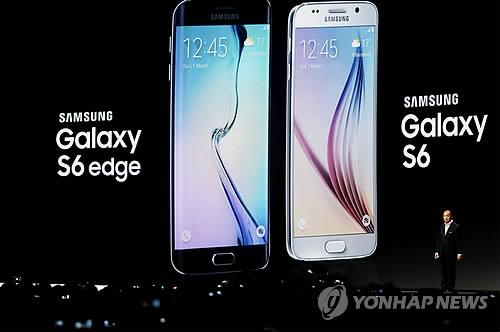
Samsung Electronics Co. showcases the Galaxy S6 and the Galaxy S6 Edge in this file photo taken on March 1, 2015. (Image : Yonhap)
SEOUL, Dec. 18 (Korea Bizwire) - Samsung Electronics Co.’s new flagship smartphone, presumably the Galaxy S7, is set to be showcased at a tech exhibition slated for February, an industry source said Friday, with the device expected to put more emphasis on performance over design.
The South Korean tech giant will reveal the new Galaxy at the Mobile World Congress 2016 in Barcelona, the source said, with the official release slated for March.
Industry watchers said the Galaxy S7 will look similar to its predecessor, the Galaxy S6, which went on sale in April, as the market cheered the design of the Galaxy S6 and its sister Galaxy S6 Edge. Thus, Samsung may utilize the design once again and instead focus its efforts on performance, they added.’
The Galaxy S7 is expected to maintain the built-in battery adopted by the predecessor, which was considered as a deal breaker for some Samsung fans who opted for Galaxies over iPhones for detachable batteries.
Users, however, may be allowed to insert memory cards to expend data capacity for the new Galaxy, a feature that also disappeared with the Galaxy S6.
The Galaxy S7 is also forecast to come with new features, such as a new touch system that delivers different commands depending on how strong a user presses the screen, similar to that adopted by the iPhone 6S.
The new Galaxy will also have a slightly larger screen at 5.2 inches, compared with its predecessor’s 5.1-inch display.
As the Galaxy S6 Edge and the Galaxy S6 Edge+, which sparked an unexpected sensation in the market with their displays that bend at both ends, Samsung may also add another Edge model for the Galaxy S7.
While no price details have been provided so far, industry watchers expect Samsung will have no choice but to cut costs amid the booming popularity of budget handsets in the market.
During the initial release, the price tag on the 32GB Galaxy S6 was 858,000 won (US$726.81), while that of the 64GB edition stood at 924,000 won.
Samsung said its handset shipments climbed 18 percent on-quarter to 105 million units in the third quarter, with smartphones accounting for around 80 percent, or 84 million units.
Despite increased shipments, its IT and mobile business saw operating profits slip to 2.4 trillion won, from the previous quarter’s 2.7 trillion won, due mainly to the increased shipment of budget models that lacked profitability.
(Yonhap)






